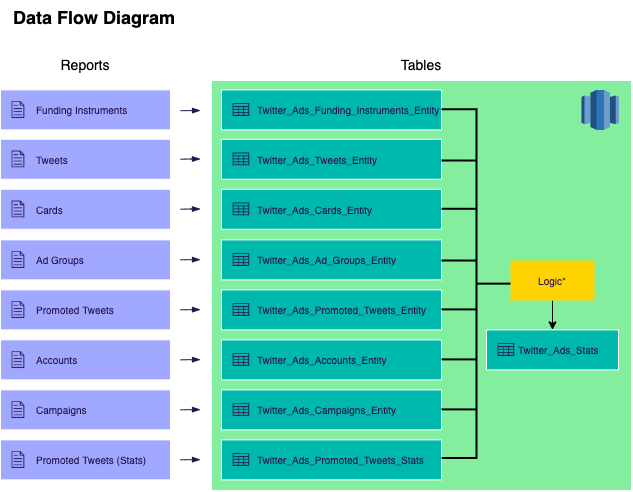The Twitter Ads kit uses the associated Stats report as a base table and adds in the appropriate Entity Tables. Each kit will have the Tweet Information and associated metrics including: number of clicks, impressions, spend, video_views, conversion values, purchases, replies, retweets, follows, likes, and engagement by date.
This kit includes…
Twitter Promoted Tweets Rivers
- Data ingestion rivers for Promoted Tweets Entity, Tweets Entity, Ad Groups Entity, Campaigns Entity, Accounts Entity, Cards Entity, Funding Instruments Entity, Promoted Tweets Stats
- Master orchestration River
- This includes logic to Join Entity/Stats Tables
- Output Tables:
- Twitter_Ads_Accounts_Entity
- Twitter_Ads_Cards_Entity
- Twitter_Ads_Tweets_Entity
- Twitter_Ads_Campaign_Entity
- Twitter_Ads_Funding_Instruments_Entity
- Twitter_Ads_Ad_Groups_Entity
- Twitter_Ads_Promoted_Tweets_Entity
- Twitter_Ads_Promoted_Tweets_Stats
- Twitter_Ads_Stats (entity and stats combined)
Minimum RPU Consumption: 9
You can find the full contents, data model documentation, and source fields used here.
Configuring this template for use
In this template, there are three variables that need to be initialized to make for dynamic use of the target configuration.
- {SCHEMA_Twitter_Ads} is used in all Target configurations and queries as the target schema name.
- {Twitter_Ads_Failure_Group} is used as the alert email address(es) for when a river fails.
- {aws_file_zone} is used as the File Zone Bucket for all Redshift Target configurations. This variable should already be populated in your Rivery account as long as a Redshift connection has previously been created.
Go to the Variables menu on the left side navigation bar and create variables for SCHEMA_Twitter_Ads and Twitter_Ads_Failure_Group. Then fill in the values as the Redshift schema where you would like the data to land and the email address(es) to which you would like the failure emails sent.














































